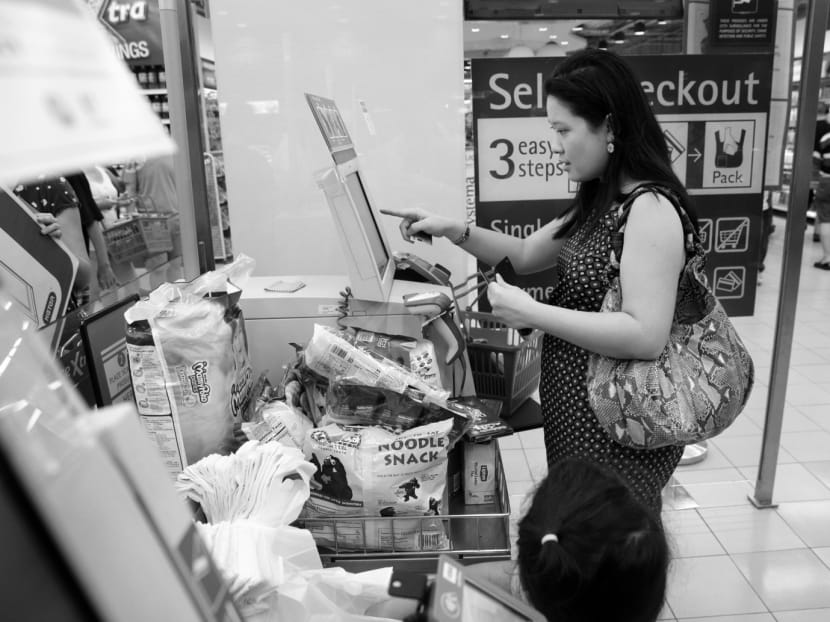The obstacles to a DIY nation
Over the years, there has been a proliferation of self-service technologies (SSTs) in various retail outlets and restaurants in Singapore. Moviegoers can purchase tickets from AXS stations, shoppers can pay and bag their own grocery at self-checkout kiosks in supermarkets and customers can place their food orders using self-ordering applications on tablets.

A woman at a self-checkout machine at Fairprice Xtra at nex shopping mall on Sunday. Using self-service technology can instil a sense of being in control and independent. TODAY File Photo
Over the years, there has been a proliferation of self-service technologies (SSTs) in various retail outlets and restaurants in Singapore. Moviegoers can purchase tickets from AXS stations, shoppers can pay and bag their own grocery at self-checkout kiosks in supermarkets and customers can place their food orders using self-ordering applications on tablets.
Still, the take-up rate for such systems has been slow and not as widespread as it ought to be in Singapore.
A recent campaign by the National Productivity Council (NPC), called We are InDIYpendent, saw several supermarkets rolling out promotions to encourage more customers to use their self-checkout kiosks.
This concerted push is timely. Customers should get used to such DIY —do it yourself — services. In fact, this innovation has been around since the mid-2000s. But it was only adopted by Singapore supermarkets in the past two years.
What is the cause of this long lag?
A survey in July by the NPC can shed some light. It found that 40 per cent of 1,033 respondents did not notice any self-service facilities in shops or restaurants, suggesting that companies are still hesitant in investing too much in SSTs too soon.
There are valid reasons for companies to be slow in adopting these self-service systems.
Despite Singapore being a generally tech-savvy society, there are people who still refrain from using such technology as they are used to a culture of receiving personal assistance.
In the same survey by NPC, among those who would not consider using SSTs, 20 per cent said they preferred being served while 17 per cent wanted someone else to do things for them.
Nonetheless, a greater barrier preventing people from using self-service systems is their perception that it is difficult to use the machines and the associated risk of causing inconvenience to others. One-third (34 per cent) of those polled said they were not sure how to use the machines, 22 per cent said the machines look too complicated and 21 per cent said they do not want to hold up the queue.
SERVING YOURSELF
The benefits of self-service systems are evident. From the company’s perspective, adopting such technology can satisfy consumers’ need for faster service and at the same time alleviate problems of manpower shortage.
Genki Sushi, for example, has experienced positive results from implementing the self-ordering system. Their employees are no longer hurried to take multiple orders and are freed up to provide better service to their customers. This has in turn enhanced their operational efficiency and productivity.
From the consumer’s perspective, these systems offer the benefit of faster service. On top of that, using self-service technology could instil a sense of being in control and independent.
According to a paper published this year by researchers from the University of Toronto, University of Rochester, and National University of Singapore, using self-service systems help consumers avoid embarrassment and frustration in conveying complicated orders.
In one of their experiments involving more than 10,000 transactions at a major alcohol retailer in Sweden, the implementation of self-service systems increased the purchase of difficult-to-pronounce items. In another experiment, the researchers compared more than 160,000 orders made before and after the introduction of Web-based ordering at a pizza delivery restaurant in a big city and found that online ordering increased the likelihood of customised orders.
Automation is rapidly becoming a way of life. While people should be more open in embracing technology, companies should also introduce self-service systems that cater to the needs of consumers so that they would find it useful and be less resistant in using them.
Thus, these systems should be designed with a customer focus. As such, customers should be consulted and involved in the design of the interface. When it is more user-friendly, customers feel less apprehensive, more in control, and more likely to use these systems.
Generating positive first impressions about using these self-service systems is also critical. In the initial stage of rolling out the systems, employees should always be on hand to assist customers and let them know that it is perfectly fine to seek help.
Over time, customers will voluntarily use the technology and even spread positive word-of-mouth recommendations to their friends if it is personally rewarding and delightful to use. But these systems should not be seen as a replacement for customer service altogether. Human beings are social animals. When we talk to people, we feel happier. Sometimes customers feel important and special when they talk to service employees and transactions become more meaningful amid such interactions.
While more companies implement these self-service systems, they should bear in mind that such technology is meant to improve service standards and not to be a hindrance to customers as that could hurt their business.
ABOUT THE AUTHOR:
Charlene Y Chen is an assistant professor in Marketing and International Business at Nanyang Technological University. Her research focuses on emotions and consumer behaviour and she teaches Relationship Marketing at Nanyang Business School.






